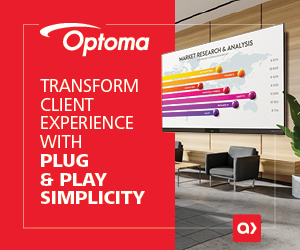This is part three of a three-part blog series on ARHT Media’s new Holographic TelePresence technology, distributed in the U.S. exclusively through Almo Professional A/V. Find part one here and part two here.
You’re in conference calls with partners and coworkers multiple times a day, day after day, week after week. Naturally, you can imagine 2D video meetings have gotten a little old and unimaginative.
ARHT Media and Almo Professional A/V have joined forces. The new partnership brings Holographic TelePresence technology and a new platform for it called the Virtual Global Stage. In case you have not heard, this exciting solution is coming soon to a virtual stage design near you.
While COVID-19 was completely unexpected, we now know a lot more about how work, UCC (unified communications and collaboration) and meeting culture will change. Acting upon this new knowledge now is totally in your power.
ARHT Media’s Holographic TelePresence technology, distributed exclusively in the U.S. through Almo Professional A/V, could pay off big and change how your customers see virtual and hybrid meetings.

What Is Holographic TelePresence and Who Is It For?
Previously, we talked about why now is the perfect time for holographic telepresence technology. Then, we dug a little deeper to understand how the technology works. (distinguishing ARHT’s HumaGram technology from actual “holograms”). Below, you will learn about the applications for holographic technology.
What is hologram technology used for? Here are a few applications for which Holographic TelePresence is a perfect fit:
Higher education. Yes, we can do our virtual teaching through video conferencing platforms. But with more than a few people on each session, the personal feel you’re yearning for pretty much vanishes. Classrooms are an ideal place for interactive holographic displays. Why? Because holograms prove particularly useful where a connection is valued.
In the classroom, there’s great importance in seeing facial expressions, storytelling through body language, reading the room before moving onto the next lesson. As great as it is to have Zoom and Teams for digital learning, truly connecting on a 2D platform is tough. Add holography, and picture the wildly enriched lectures and engaging experiences.
Corporate and UCC spaces. The second application to consider as a use case for Holographic TelePresence is corporate. Holographic TelePresence takes the idea of a virtual meeting and infuses it with new energy and possibilities.
While, for now, we see holographic display images used by the C-Suite, widespread use is very possible. In corporate environments, remote or otherwise, ARHT’s technology breaks down the limitations of 2D. Hologram tech in a virtual environment creates an interactive experience that benefits viewers and hologram presenters alike.
Live events, meetings and conferences. Live event programming, while fun and valuable, costs a fortune. Highly desired speakers only have so much time and availability. Consider the possibilities if, suddenly, neither travel nor a large venue were needed. That alone is enough to make an event planner smile.
How great would it be to virtually stage a room and have world-class speakers (think religious leaders, CEOs, politicians, celebrities) at virtual events if the in-person feel was maintained? Booking speakers virtually (who can “beam in” from their remote setup instead of getting on a plane) saves time and finances — plus, it greatly lessens the environmental impact. Through Holographic TelePresence, it’s as though hologram presenters are on stage next to each other.
A Visual Edge and an Emotional Draw: Now Is The Time for 3D Holographic Display Tech
Especially lately, high-status speakers like celebrities are in high demand. But does a 2D video appearance create the connection that an in-person one would? No.
3D hologram meetings and hologram teleconferences deliver a more lifelike presentation and create a bigger emotional draw. In an interview with Inavate Magazine, ARHT Media CEO Larry O’Reilly highlighted an example from December 2018 with “Aquaman” star Jason Momoa.
“He was rehearsing for Saturday Night Live [in New York City],” said O’Reilly. “On Thursday night, he just went to a different studio at 30 Rock, and we beamed him into Mexico City for fan engagement and media events at the IMAX theatre there. The next night, we beamed him into Comic-Con Brazil, where he addressed over 3,000 people live.”
Through its Virtual Global Stage, ARHT leverages the proprietary transmission software that powers its HoloPresence (or “holographic presence”) platform to “beam” multiple presenters into a virtual, online environment. Human holograms then appear in lifesize proportions and can interact with audience members (and the other panelists) virtually.
Hologram solutions are beyond what your customer even knows.

Big names are already using Telegraphic HoloPresence — like actor Jon Hamm, Santa Claus, the inventor of basketball and even the Crown Prince of Dubai. (By the way, all those names are impressive, but we know we had you at Jon Hamm.)
Some may claim that hologram media is a trend — or they’ll say it’s just emerging — but we know otherwise. The benefits of an enhanced teaching presence, a cutting-edge guest appearance or a town hall that doesn’t put you to sleep are massive. We’ve heard people say that futuristic solutions like human hologram technology are just a solution just looking for a problem. COVID-19 has changed this reality.
For more information, visit www.almoproav.com/holographic-telepresence, and get in touch with your Almo regional service development manager today.






